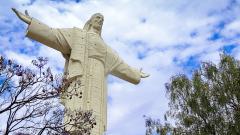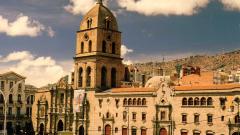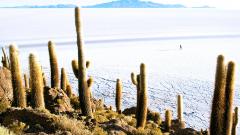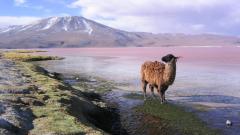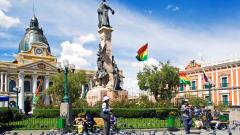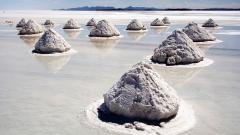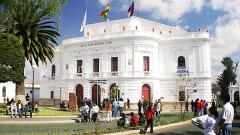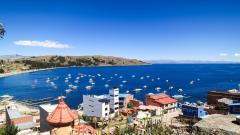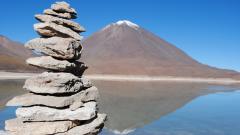 travel to Bolivia
travel to Bolivia
GENERAL CHARACTERISTICS
Bolivia or officially Plurinational State of Bolivia is a sovereign country located in the central-western region of South America, the country has an area of 1.098.581 km² divided into nine departments and 113 provinces, accommodating 10.825.013 inhabitants. The capital of the country is located in La Paz, the third most populated city in the country, which is located west of the territory.
The official currency is Bolivian, which with the current appearance, has been in circulation since 1987.
There are three official languages: Spanish, Aymara and Quechua. Other 36 pre-Columbian languages are recognized as co-official. The first one is spoken by almost 90% of the population, while the second, prior to the Inca period, covers 11% of the population. Quechua, on the other hand, has a greater acceptance, being understood by approximately a quarter of it. The rest of the languages are spoken locally in their origin regions.
HISTORY
During the pre-Hispanic period there were numerous cultures throughout the current territory, the Tiwanaku tribe settled around the Titicaca Lake around 1100 a.C. and it is believed that they were the architects of the oldest ruins in Bolivia, beautifully made, and with uncertain origin, constitute one of the tourist references of the country. They are located in Tiahuanaco, a town located 70 km from the capital. After the disappearance of this one, the Aymara tribe takes control of diverse regions of Bolivia and Peru and maintains its hegemony until the arrival of the Incas in 1438, that extend by the territory, but they didn’t manage to invade the Bolivian east due to the resistance of the indigenous people.
Approximately one hundred years later, the Spanish invasion took place, they founded different cities, La Plata (current Sucre) in 1538, La Paz in 1548, Santa Cruz de la Sierra in 1561 or Cochabamba in 1571. Potosí was the main city of the Viceroyalty of Charcas thanks to the exploitation of its silver mines, becoming the largest producer of this mineral of the time. After this period of splendor, the appearance of new techniques of extraction, the progressive exhaustion of the raw material, and the appearance of new booming industries, accelerated the decline of the viceroyalty.
The firsts liberation attempts that emerged at the beginning of the 19th century were put down, and it was not until 1823 that Simon Bolivar's troops entered the territory attacking the Spanish troops. The most decisive battle took place that same year in Ayacucho, which supposed a great advance in the liberation, which would be completed in 1825 with the Declaration of Independence.
TOURISM
The largest number of visitors is concentrated in La Paz, which stands out for its cultural and natural heritage. In the center of the city we find Plaza Murillo, where we will see various monuments such as the Palacio Quemado (seat of the Executive Power), the Legislative Palace and the or the Government Palace built in 1845. The Church of San Francisco stands out as one of the religious references in the capital. It was finished in the year 1753, is an exponent of the Baroque style. It also contains a museum, an important art gallery and historical-religious elements. In the same square we will find another sacred monument, The Metropolitan Cathedral of Nuestra Señora de La Paz, has a neoclassical style, it’s known for its altar and its mausoleum.
Along the streets of Sagárnaga and Linares there is the Market of the Witches, where we can buy amulets, bracelets, objects of local crafts and other souvenirs.
In addition to these resources, we can enjoy excellent views of the city if we visit any of its viewpoints, including the Centro Ceremonial Andino viewpoint, the Jach'a Kollo Viewpoint (Cerro Grande), the Killi Killi Viewpoint and Alto Pampahasi viewpoint.
Another of its most important tourist centers in Bolivia, is the city of Santa Cruz de la Sierra, hosts many cultural entertainment spaces and a remarkable cultural heritage.
The center of the city is formed by the Plaza 24 de Septiembre, where we can see buildings of colonial style. The most important are the Metropolitan Cathedral, inside which is located the Cathedral Museum of Sacred Art, where visitors will enjoy a large collection of objects belonging to the Jesuit missions. We must also visit the City Hall and the House of Culture.
Sucre, is the cradle of Bolivian independence, so there are lots of historic buildings available to visit, it was declared a World Heritage Site by Unesco. We can see among other monuments the House of Liberty, which houses a museum of Bolivian nation, The Metropolitan Cathedral is considered one of the most beautiful in the country. Built with a Renaissance and Baroque style. In addition, a sector of it works as a museum of sacred art, one of the most important in Bolivia.
Other religious monuments that are worth visiting are San Felipe Neri Convent and La Recoleta Monastery.
There are several museums in the city, the most important is the Treasure Museum. Other interesting museums are the Santa Clara Museum, the Asur Indigenous Art Museum, the Charcas Museum, or the Anthropological Museum.
Potosí, the main commercial center during the colonial era, was declared a World Heritage Site by Unesco, thanks to the significant monuments that remind us of the Spanish heritage and the rich history of the city. There, we can visit:
The Cathedral of Potosí, built in 1808, has a central dome and two towers. It is one of the most characteristic temples of Neoclassicism. Inside there are important religious relics of gold and silver. A sector of this works as a museum of religious art.
The Tower of the Company, is one of the symbols of the city is a religious convent of the eighteenth century, its construction was conceived as an arc of triumph. If you get to the top of the tower you get a privileged view of the city.
La Casa de la Moneda has been converted, and today, it is the main museum in Potosí, it is distributed around different rooms devoted to painting and the arts, to history and to numismatics. The building is an unmissable architectural reference.
Within the municipality we locate the city of Tupiza, also known as Joya Bella of Bolivia whose main attraction is the Fiesta de Reyes, a festival that gathers a large number of activities and is celebrated during the Christmas season. It also attracts tourists for the beauty of its landscapes and hills, its music and its gastronomy.
One of the most important tours in the city is the visit to the Minas del Cerro Rico where you will see several caves from where the ore is mined, the way of life of the miners, their working conditions and a mining market.
About seven hours away from the capital, we find Cochabamba, the third most important city in the country known as the city of the valleys, it enjoys wide parks and many tourist attractions. It conserves religious buildings such as the Metropolitan Cathedral or the Church of Santo Domingo, some open-air parks such as the Mariscal Santa Cruz Park or the Alalay Lagoon, and some museums, such as the Archaeological Museum, the Art Museum or the Puerto Portales cultural centre.
The most recognized monument of Cochabamba is the Cristo de la Concordia located on the top of Cerro San Pedro, where we can reach thanks to a cable car, there, you will have an excellent view of the city.
Continuedly, we must emphasize their natural resources, since they great beauty and international recognition, Titicaca Lake, which has its territory shared with Peru, offers us multiple municipalities, beaches and islands, where beyond relax, we can admire beautiful religious relics of the pre-Columbian era. The Madidi National Park was declared by the National Geographic magazine one of the twenty places with the greatest tourist interest in the world. The tourist attraction of the place is due to its magnificent jungle, its great biodiversity in flora and fauna, which can be seen through organized tours, walks, descents in rappel etc. We can enjoy of sports and adventure activities such as swimming in its lagoons, sport fishing, navigation in the rivers, expeditions along the tropical forest, interaction with the native communities of the region, birdwatching, alligators and other species.
Another noteworthy reserve is the Noel Kempff Mercado National Park named World Heritage Site in 2000. It serves as a habitat for 4000 plant species and a large amount of fauna, highlighting the birds, but the park is known for its impressive waterfalls, thanks to which has become a benchmark for ecotourism.
Finally, in the department of Potosí we can visit El Salar de Uyuni, the largest salt desert known, where you can see various animals, giants cactus and archaeological remains with more than 3000 years old. All the hotel complexes are formed by blocks of salt which gives them a unique aspect.
Bolivia is a territory with great natural enviroment, a remarkable landscape diversity, rich ancestral traditions that make it the most indigenous country in South America, and also warm people that make our tourism experience full, different and welcoming.
REQUIRED DOCUMENTATION
A valid passport and round-trip ticket is required to enter Bolivia, except for citizens from Mercosur member countries (Paraguay, Peru, Ecuador, Colombia, Brazil, Uruguay, Chile and Argentina) who can present their document of identity. For citizens of countries endemic to yellow fever, a vaccination certificate against yellow fever may be required.
Some passengers must present a tourist visa, for this please consult the following web page (in Spanish): https://www.boliviaturismo.com.bo/documentos-visas-para-ingresar.php
The time of stay in Bolivia is 90 days with the possibility of an extension for travellers from countries of the Andean Community, 90 days without extension for citizens of countries associated with Mercosur, and 30 days with up to two extensions per year for the other nationalities.
EMBASSIES AND CONSULATES: https://www.embassypages.com/bolivia
PRINCIPAL AIRPORTS OF BOLIVIA
- El Alto International Airport, in La Paz (Codex LPB)
- Jorge Wilstermann International Airport, in Cochabamba (Codex CBB)
- Viru Viru International Airport, in Santa Cruz de la Sierra (Codex VVI)
- Alcantarí International Airport, in Sucre (Codex ALC)
practical information
useful information before leaving
Language
Religion
Political regime
Currency
Warnings
Documentation
Vaccines
recommendations
Recommendations before traveling to Bolivia
SECURITY
El Alto, certain neighbourhoods of La Paz and Santa Cruz de la Sierra are insecure, so we must estimate precautions.
It is recommended not to travel alone in the interior of the country, as well as to avoid traveling by road at night to remote and sparsely populated areas.
The roads also have an improbable condition, which is why traffic problems and accidents are common. You must be cautious of both driver, passenger or passer-by
If you need a taxi, it is advisable to hire it through your tourist accommodation or an official agency to avoid kidnappings or robberies.
It is recommended to monitor our belongings and not show signs of wealth in large urban centres.
During the rainy season (November to February) floods and landslides are frequent. The departmental health services (SEDES), offers on its website updated information on this matter.
Before hiring a trip or tourist package, especially when it comes to adventure tourism or visits to areas is recommended to process it in an agency that is part of the Bolivian Association of Travel Agencies and Tourism (ABAVYT) and has with the international IATA accreditation.
HEALTH
Much of the territory is at a considerable altitude, so if you are not used to this situation can be affected by altitude sickness, visits to cities such as La Paz (3800 metres) or Potosi (4067 metres) are not advisable for people with respiratory or cardiac problems. Try not to make great efforts, and if you suffer, it is recommended to rest, not drink alcohol or eat a lot, drink plenty of fluids, you can also treat with coca tea infusions.
Outbreaks of Dengue, Chikungunya, Zika have been detected in those cities that are below 1700 metres, the main focuses are in the municipalities of Pando, Beni, Santa Cruz, Tarija, Chuquisaca and Cochabamba. To prevent contagion, we must use long-sleeved shirts and long pants, use mosquito repellent, cover any container in which water is stored and soft drink bottles. Also in 2017, there have been affected by yellow fever. And the country is considered the focus of the disease.
It is made known that the sanitary conditions, in general, are quite deficient.
CLIMATE AND TEMPERATURES
In the country, we distinguish two seasons: rainy and dry. The rainy season covers from November to March, and the dry season from March to October. Although the climate will vary according to the region where we are located, it can be classified by areas; a humid tropical climate with an average temperature of 30 ° C in Los Llanos, where we will also witness significant rainfall. As of May, the precipitations descend and the days are more clear; in the Altiplano the climate will be cooler reaching, on average, 59-68ºF. At night temperatures drop drastically approaching 32°F, so frost and the presence of snow is common.
The Chaco has a semi-arid tropical climate that brings with it rain and humidity from January. The rest of the months are dry, with hot days and cool nights.
The mountain climate, as is logical, varies according to the altitude, with the lowest temperatures in the highest peaks, being able to witness snow from 2000 metres, but in general it is a wet and rainy area.
BUSINESS HOURS
Banks are open Monday through Friday from 9:00 a.m. to 4:00 p.m. in large areas we will find some who work until 7:00 p.m. Currency exchanges can be made in all banks, some hotels and in exchange houses.
TIPS
In most cases, to make payments in the establishments will be necessary to present some identity document. The most known credit cards will be accepted.
ELECTRICITY
The electrical voltage in Bolivia is 230 volts, and the frequency is 50 Hz. The types of plugs used are A and C. See if you need an adapter.
TELEPHONES OF INTEREST
The telephone prefix of the country is +591.
The Telephone of the Tourist Police 222.50.16, the one of the local police (radio patrols) is 110, to warn to the firemen it marks 119 and for emergencies the 118 (in the city of La Paz).
TIME ZONE
The time zone of Bolivia corresponds to UTC-4.

